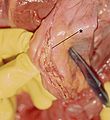Aortic dissection
Jump to navigation
Jump to search
The printable version is no longer supported and may have rendering errors. Please update your browser bookmarks and please use the default browser print function instead.
Aortic dissection, abbreviated AoD, is an uncommon condition with a relatively high mortality.
General
Risk factors:
- Hypertension.[1]
- Atherosclerosis.[2]
- Cardiac surgery - rare, well-known complication.[3]
- In one large registry, approximately 15% of acute dissections are associated with prior cardiac surgery.[4]
Note:
May be separated into two groups:[5]
- Hypertension + atherosclerosis, typically 40-60 years old.
- Connective tissue disorders - "young".
Associations
Heritable:[6]
- Marfan's syndrome.
- Loeys-Dietz syndrome - a Marfan-like syndrome[7]
- Ehlers-Danlos syndrome.
- Bicuspid aortic valve.[2]
Others:
- Tertiary syphilis.[8]
- Turner syndrome.[9]
Classification
Two classification exist:
- DeBakey.
- Stanford.
Stanford dissection classification:[10]
- Type A - aortic root to the left subclavian artery.
- Considered a surgical emergency.
- Type B - distal to (left) subclavian artery.
- Generally, treated conservatively.
Gross
- Entry intimal tear +/- exit intimal tear.
- Blood between layers of the vessel wall.
Images
www:
Microscopic
Features:
- Defect in the tunica media (muscle layer).
- "Abundant" fresh blood in the adventitia.
- +/-Changes of cystic medial degeneration - a specific histopathologic cause of aortic dissection.
DDx:
Images
www:
Stains
- Alcian blue-PAS - no ground substance - see cystic medial degeneration.
- Elastin stain - no extensive fragmentation of the elastin fibres.
Sign out
PORTION OF AORTA, EXCISION/REPAIR: - AORTIC WALL WITH EVIDENCE OF DISSECTION. - NO SIGNIFICANT INFLAMMATION. - NO MICROORGANISMS IDENTIFIED WITH ROUTINE STAINS. - NO EVIDENCE OF CYSTIC MEDIAL DEGENERATION, SEE COMMENT. COMMENT: An elastic staining does not demonstrate fragmentation of the elastin fibres. No degenerative changes of the media are apparent with Alcian blue-PAS staining.
See also
References
- ↑ Braverman, AC. (Oct 2011). "Aortic dissection: prompt diagnosis and emergency treatment are critical.". Cleve Clin J Med 78 (10): 685-96. doi:10.3949/ccjm.78a.11053. PMID 21968475.
- ↑ 2.0 2.1 2.2 LeMaire, SA.; Russell, L. (Feb 2011). "Epidemiology of thoracic aortic dissection.". Nat Rev Cardiol 8 (2): 103-13. doi:10.1038/nrcardio.2010.187. PMID 21173794.
- ↑ Leontyev, S.; Borger, MA.; Legare, JF.; Merk, D.; Hahn, J.; Seeburger, J.; Lehmann, S.; Mohr, FW. (Mar 2012). "Iatrogenic type A aortic dissection during cardiac procedures: early and late outcome in 48 patients.". Eur J Cardiothorac Surg 41 (3): 641-6. doi:10.1093/ejcts/ezr070. PMID 22345184.
- ↑ Teman NR, Peterson MD, Russo MJ, et al. (September 2013). "Outcomes of patients presenting with acute type A aortic dissection in the setting of prior cardiac surgery: an analysis from the International Registry of Acute Aortic Dissection". Circulation 128 (11 Suppl 1): S180–5. doi:10.1161/CIRCULATIONAHA.112.000342. PMID 24030404.
- ↑ URL: http://path.upmc.edu/cases/case84/dx.html. Accessed on: 13 May 2014.
- ↑ Gleason TG (2005). "Heritable disorders predisposing to aortic dissection". Semin. Thorac. Cardiovasc. Surg. 17 (3): 274-81. doi:10.1053/j.semtcvs.2005.06.001. PMID 16253833.
- ↑ Loeys BL, Schwarze U, Holm T, et al (August 2006). "Aneurysm syndromes caused by mutations in the TGF-beta receptor". N. Engl. J. Med. 355 (8): 788-98. doi:10.1056/NEJMoa055695. PMID 16928994. http://content.nejm.org/cgi/content/full/355/8/788.
- ↑ Cruz, RP.; Marrone, LC.; Marrone, AC. (Nov 2010). "Chronic syphilitic aortic aneurysm complicated with chronic aortic dissection.". Am J Surg 200 (5): e64-6. doi:10.1016/j.amjsurg.2010.02.017. PMID 20864080.
- ↑ Carlson, M.; Silberbach, M. (2009). "Dissection of the aorta in Turner syndrome: two cases and review of 85 cases in the literature.". BMJ Case Rep 2009: bcr0620091998. doi:10.1136/bcr.06.2009.1998. PMID 21731587.
- ↑ Finkelmeier BA (September 1997). "Dissection of the aorta: a clinical update". J Vasc Nurs 15 (3): 88-93. PMID 9362838.

